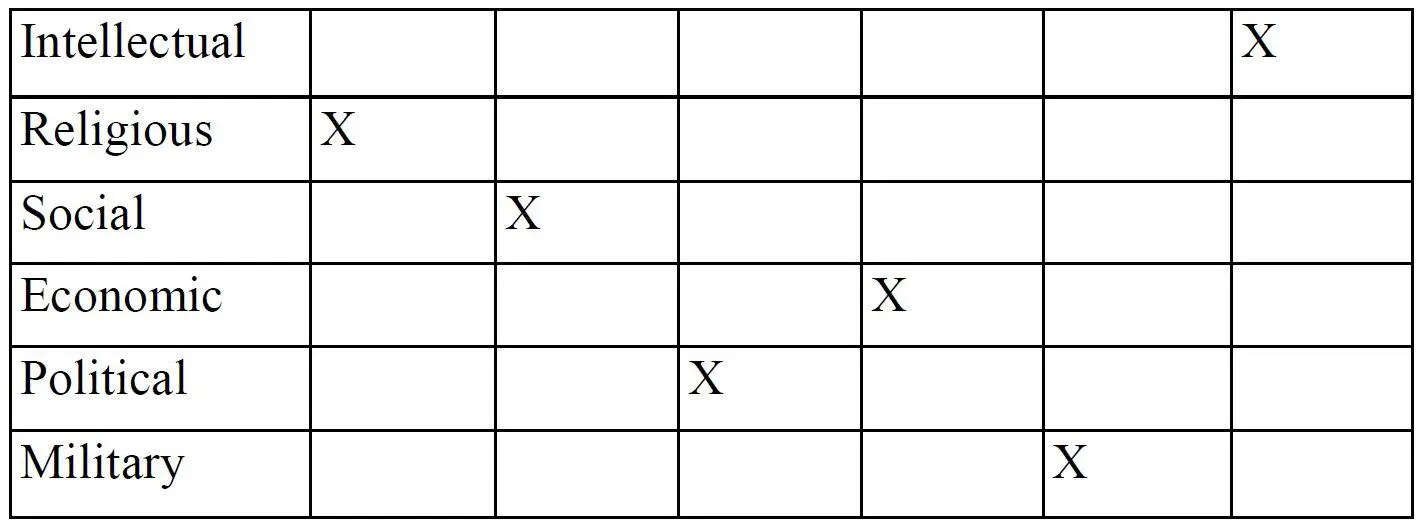When an institution has been reformed or circumvented, there is once again an instrument on the level in question, and the purpose of that level is achieved with relative effectiveness. But, once again, as always happens, the new instrument becomes an institution, effectiveness decreases, tension of development rises, and conflict appears. If the outcome of this conflict is either reform or circumvention, effectiveness increases and tension decreases. If the outcome is reaction, ineffectiveness becomes chronic and tension remains high.
As a result of this process of historical development, the development of each level appears in history as a pulsating movement. Periods of economic prosperity alternate with periods of economic stagnation; periods of religious or intellectual satisfaction alternate with periods of religious or intellectual frustration. Periods of political order or military success alternate with periods of political disorder or military disaster.
This process of historical development takes place on innumerable levels of a society because there are innumerable levels to the culture. But this process is only one aspect of the historical evolution of a society. The other aspect we call historical morphology; it is concerned with the relationships between the different levels of culture in a society.
Before we examine it, we might state, in a formal way, three definitions:
1. Historical developmentis concerned with the changes that take place on any single level of culture in a society.
2. Historical morphologyis concerned with the ways in which one level of culture influences the other levels of culture in the same society.
3. Historical evolutionis a resultant of historical development and historical morphology, both acting simultaneously and reacting on each other.
"Morphology" is a word borrowed from biology. It means that the parts of a living organism are adapted to one another. In its most obvious sense it means that a giraffe could not possibly have the neck of an elephant nor could an elephant have the legs of a giraffe. But it also has a subtler meaning. When we speak of a heavyweight boxer we frequently mention his "best fighting weight." This means that, given his height, reach, age, experience, and all the rest of his specifications, there is an optimum weight for his best fighting ability. If he is over that weight, he is slowed up; if he is under that weight, his blows lack impact. On the other hand, if he is at his best fighting weight, there is also an optimum length for his arms or an optimum height. If his reach or his height varies by much from these optimum points, his fighting ability will suffer. All of these are morphological relationships.
The same kinds of morphological relationships appear in a society. The ability of a society to defend itself on the military level is dependent on its ability to provide domestic order on the political level, wealth on the economic level, companionship on the social level, understanding on the intellectual level, and psychic certainty on the religious level. At the same time the ability of the society to defend itself affects its ability to achieve these five other goals. Thus each level is closely connected with all the others. It would be quite impossible to support a mechanized army without a fairly centralized political system, without a highly industrialized economic system, or without a fairly active scientific tradition on the intellectual level. On the other hand, a military system like feudalism, in which men fought as trained specialists on horseback, could be supported by a completely decentralized political system (in which there was no state at all) or by a purely agricultural economic system, and with an intellectual system which emphasized honor and loyalty rather than knowledge or science. Such a system existed in Western Europe about the year 1100, just as the system indicated in the preceding sentence exists in Europe in the twentieth century.
Just as there is an optimum length for a giraffe's neck (given all his other measurements as fixed), and just as there is a best fighting weight or a best length of reach for a heavyweight boxer (given all his other measurements as fixed), so also there is an optimum point of development on each level of culture (assuming all the other levels have reached fixed points of development). This optimum point for each level in relationship to the development of each other level is the point at which morphological tension is least. This means that time and energy on each level can be devoted to achieving the purpose of each level and need not be used up in interlevel friction because of the need to speed up the development of another level; nor need such energy and time be used in any one level in amounts beyond that which would be required to attain a certain degree of achievement on that level because of the inadequacies of some other level. For example, if the point of development of the political level is morphologically inadequate, more time and energy must be expended on the economic or the military level to achieve a certain amount of production or protection from these levels. All this is really nothing more than a rewording of our previous statement that culture is integrative. And just as we said, at that time, that culture never gets integrated and that it would be a bad thing if it did, so we can say here that morphological tension never reaches zero and that it would be a bad thing if it did (for then the society would be rigidly frozen into an unchanging pattern and would perish).
We can picture this somewhat more clearly with the aid of a diagram. In this diagram we shall mark, very roughly, the point which we believe our Western society has reached on each of the six levels of culture:

Each of these points is a very rough estimate because each represents the resultant of a large number of sublevels. For example, the point we have indicated on the Intellectual Level represents the resultants of a very advanced science, a very backward art, a fairly mediocre humanities, and other factors. The backwardness of our religious development or of our social developments represents the widespread frustration of these human needs, the low level of our appreciation of the nature of deity, the widespread failure to establish any feeling of relationship between this deity and man's spiritual life and, on the social level, the widespread frustration of men's gregarious needs in a society built on great cities, millions of unrecognized faces in those cities, and a general lack of established, satisfying social relationships.
The advanced point indicated on the economic and military levels indicates the extraordinary success we have had in producing wealth and in directing power against outside societies. Our amazingly high standards of living are proof of the advanced status of the economic level, while the number of outside societies that we have destroyed (from the American Indians and the Australian aborigines to Mandarian China or Mogul India) are witness to our success on the military level. The advanced states of both of these levels are largely due to the even further advanced state of our intellectual level. The fact that the latter is still in advance of the economic or military level means that its morphological influence on them is still tending to pull them forward. On the other hand, the backwardness of these two levels (and, indeed, of the three others as well) in relationship to the intellectual level is tending to hold the development of this last level back. Thus each level acts upon all the others.
The backwardness of our religious and social developments is undoubtedly holding back the development of the intellectual and political levels. At the same time, the relatively advanced state of the intellectual, economic, and military developments of our society is forcing the political development forward, while the backwardness of the political level has a tendency to hold the developments on the military, economic, and intellectual levels back. The backwardness of one level of development in respect of other levels of development is widely recognized among students of society, and is called "cultural lag."
Читать дальше











